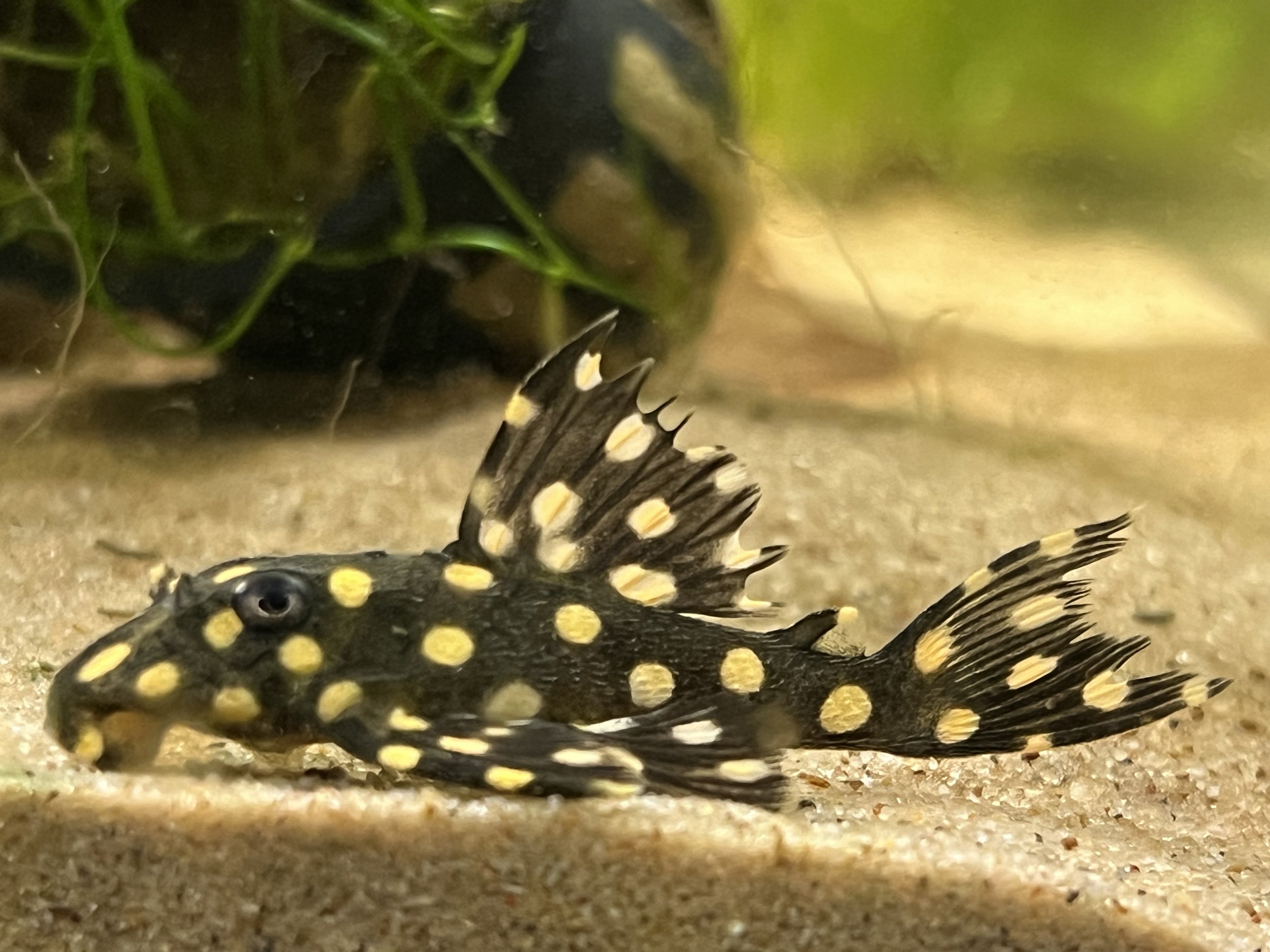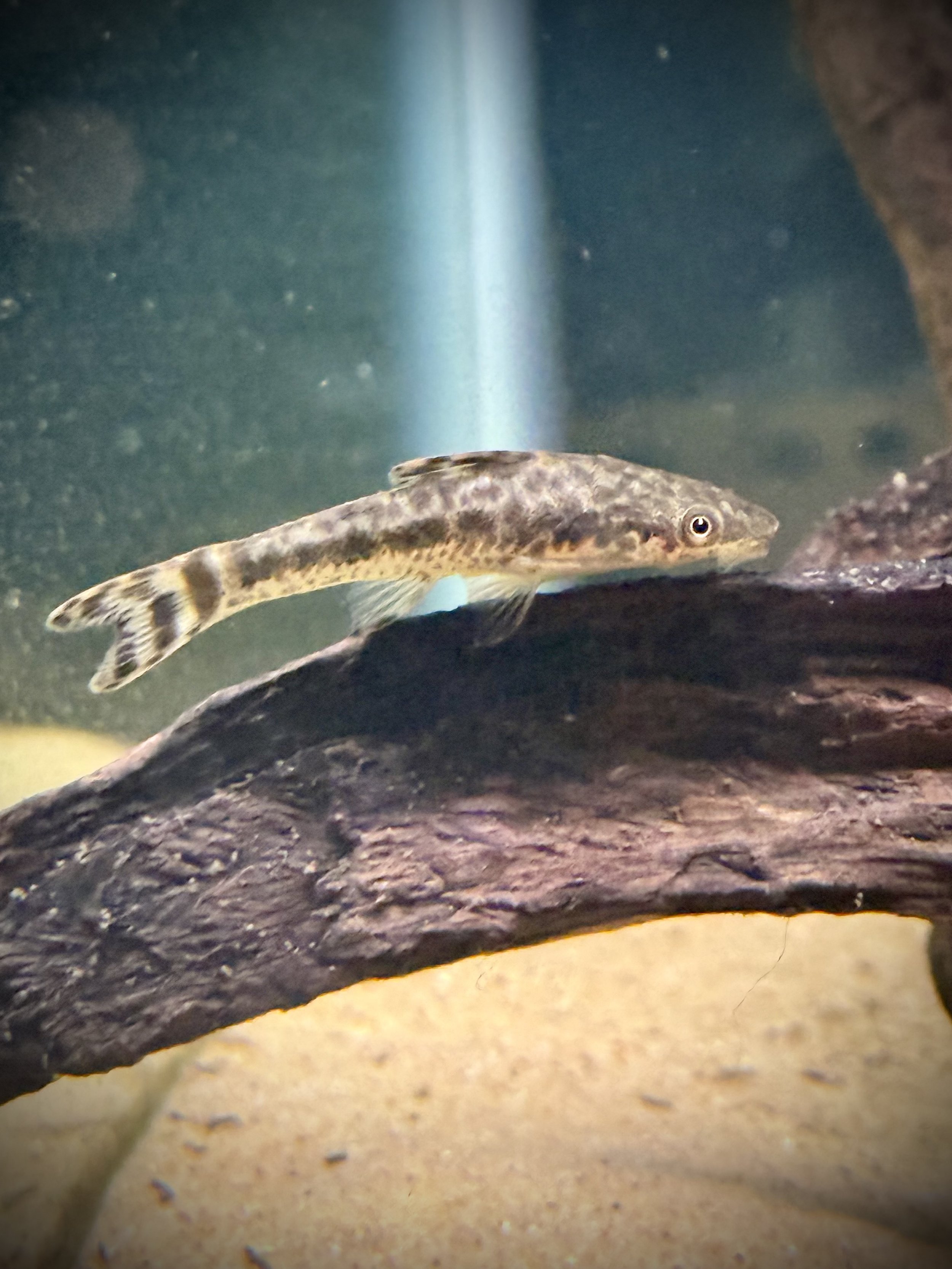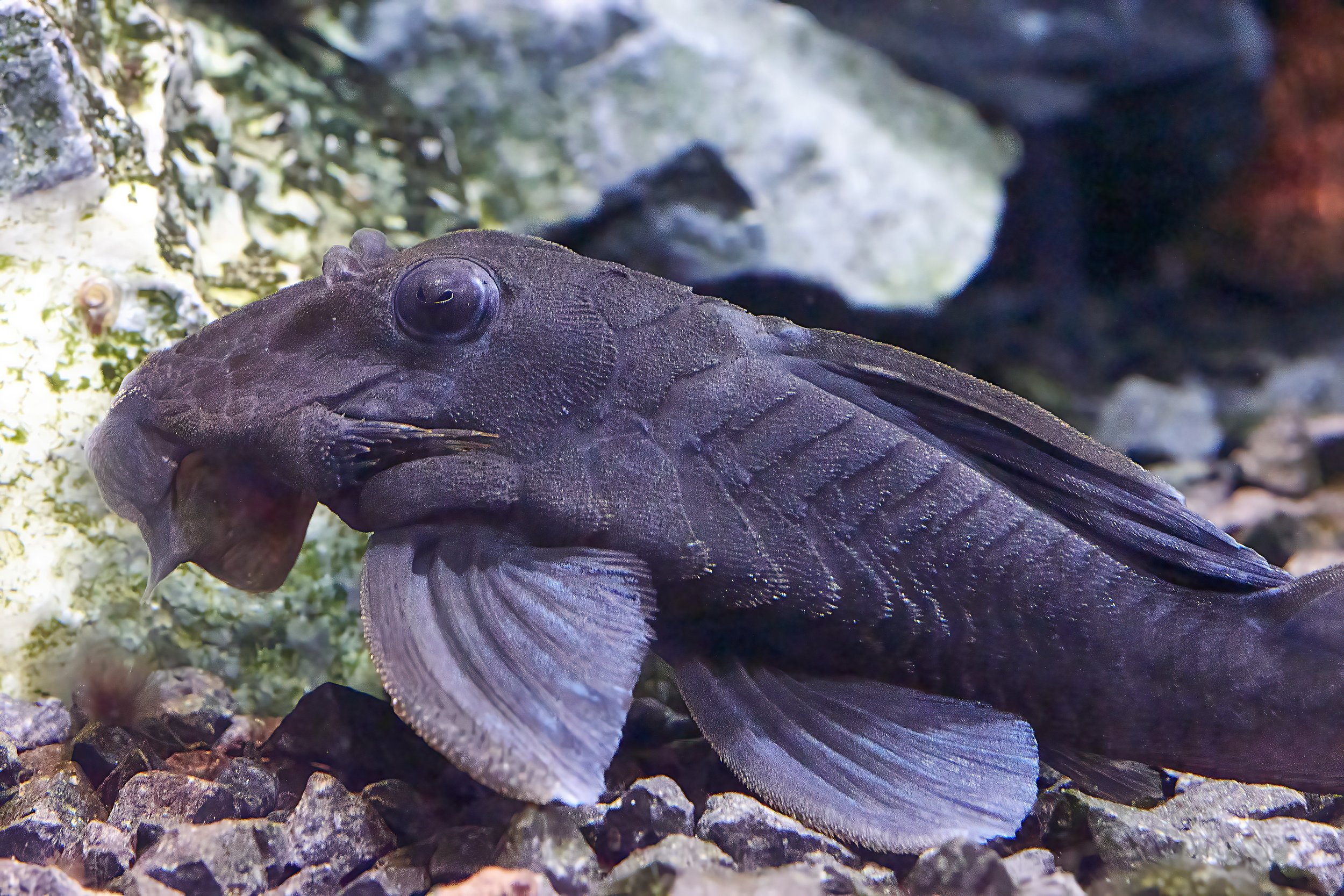 Image 1 of
Image 1 of


L201 Snowball Plecostomus
The L201 Snowball Plecostomus, scientifically known as Hypancistrus sp. L201, is a stunning freshwater fish species sought after by aquarium enthusiasts for its striking appearance and unique behavior. Belonging to the Loricariidae family, this species originates from the Amazon River basin in South America, specifically from the Rio Xingu in Brazil.
Physically, the L201 Snowball Plecostomus is characterized by its distinctive white or cream-colored body adorned with small black spots or marbling, resembling snowflakes, hence its common name. It possesses a flattened body with a broad head and a suckermouth, which it uses to attach itself to surfaces and feed on algae and biofilm. Mature specimens can reach lengths of up to 5 inches (12.7 centimeters).
In aquariums, L201 Snowball Plecos are prized for their algae-eating abilities and peaceful temperament, making them suitable additions to community tanks. However, they require well-oxygenated water with strong filtration to mimic their natural habitat conditions. Providing plenty of hiding spots such as caves, driftwood, and rocks is essential to ensure their comfort and security.
Water parameters for L201 Snowball Plecos should closely resemble those of their native Amazonian environment. They prefer warm water temperatures ranging from 75 to 82°F (24 to 28°C) and slightly acidic to neutral pH levels between 6.5 to 7.5. Regular water changes and maintenance help maintain optimal water quality and promote the health and well-being of these fish.
Feeding L201 Snowball Plecos is relatively straightforward, as they are omnivorous and primarily herbivorous in nature. They feed on algae, biofilm, and organic detritus present in the aquarium, but supplemental feeding is recommended. Offering a varied diet consisting of high-quality sinking pellets or wafers, blanched vegetables such as zucchini or cucumber, and occasional treats like bloodworms or brine shrimp ensures their nutritional needs are met.
Breeding L201 Snowball Plecos in captivity can be challenging and requires specific conditions. Providing a suitable breeding environment with caves or PVC pipes as spawning sites, along with optimal water quality and parameters, can stimulate spawning behavior. Once eggs are laid and fertilized, the male typically guards the eggs until they hatch, and the fry can be raised on a diet of specialized fry foods or powdered algae.
Overall, the L201 Snowball Plecostomus is a captivating and valuable addition to freshwater aquariums, prized for its beauty, usefulness in algae control, and peaceful nature. With proper care and attention to their specific requirements, these remarkable fish thrive and contribute to the vibrancy and diversity of any aquatic environment, bringing joy to aquarists of all levels of experience.
The L201 Snowball Plecostomus, scientifically known as Hypancistrus sp. L201, is a stunning freshwater fish species sought after by aquarium enthusiasts for its striking appearance and unique behavior. Belonging to the Loricariidae family, this species originates from the Amazon River basin in South America, specifically from the Rio Xingu in Brazil.
Physically, the L201 Snowball Plecostomus is characterized by its distinctive white or cream-colored body adorned with small black spots or marbling, resembling snowflakes, hence its common name. It possesses a flattened body with a broad head and a suckermouth, which it uses to attach itself to surfaces and feed on algae and biofilm. Mature specimens can reach lengths of up to 5 inches (12.7 centimeters).
In aquariums, L201 Snowball Plecos are prized for their algae-eating abilities and peaceful temperament, making them suitable additions to community tanks. However, they require well-oxygenated water with strong filtration to mimic their natural habitat conditions. Providing plenty of hiding spots such as caves, driftwood, and rocks is essential to ensure their comfort and security.
Water parameters for L201 Snowball Plecos should closely resemble those of their native Amazonian environment. They prefer warm water temperatures ranging from 75 to 82°F (24 to 28°C) and slightly acidic to neutral pH levels between 6.5 to 7.5. Regular water changes and maintenance help maintain optimal water quality and promote the health and well-being of these fish.
Feeding L201 Snowball Plecos is relatively straightforward, as they are omnivorous and primarily herbivorous in nature. They feed on algae, biofilm, and organic detritus present in the aquarium, but supplemental feeding is recommended. Offering a varied diet consisting of high-quality sinking pellets or wafers, blanched vegetables such as zucchini or cucumber, and occasional treats like bloodworms or brine shrimp ensures their nutritional needs are met.
Breeding L201 Snowball Plecos in captivity can be challenging and requires specific conditions. Providing a suitable breeding environment with caves or PVC pipes as spawning sites, along with optimal water quality and parameters, can stimulate spawning behavior. Once eggs are laid and fertilized, the male typically guards the eggs until they hatch, and the fry can be raised on a diet of specialized fry foods or powdered algae.
Overall, the L201 Snowball Plecostomus is a captivating and valuable addition to freshwater aquariums, prized for its beauty, usefulness in algae control, and peaceful nature. With proper care and attention to their specific requirements, these remarkable fish thrive and contribute to the vibrancy and diversity of any aquatic environment, bringing joy to aquarists of all levels of experience.
The L201 Snowball Plecostomus, scientifically known as Hypancistrus sp. L201, is a stunning freshwater fish species sought after by aquarium enthusiasts for its striking appearance and unique behavior. Belonging to the Loricariidae family, this species originates from the Amazon River basin in South America, specifically from the Rio Xingu in Brazil.
Physically, the L201 Snowball Plecostomus is characterized by its distinctive white or cream-colored body adorned with small black spots or marbling, resembling snowflakes, hence its common name. It possesses a flattened body with a broad head and a suckermouth, which it uses to attach itself to surfaces and feed on algae and biofilm. Mature specimens can reach lengths of up to 5 inches (12.7 centimeters).
In aquariums, L201 Snowball Plecos are prized for their algae-eating abilities and peaceful temperament, making them suitable additions to community tanks. However, they require well-oxygenated water with strong filtration to mimic their natural habitat conditions. Providing plenty of hiding spots such as caves, driftwood, and rocks is essential to ensure their comfort and security.
Water parameters for L201 Snowball Plecos should closely resemble those of their native Amazonian environment. They prefer warm water temperatures ranging from 75 to 82°F (24 to 28°C) and slightly acidic to neutral pH levels between 6.5 to 7.5. Regular water changes and maintenance help maintain optimal water quality and promote the health and well-being of these fish.
Feeding L201 Snowball Plecos is relatively straightforward, as they are omnivorous and primarily herbivorous in nature. They feed on algae, biofilm, and organic detritus present in the aquarium, but supplemental feeding is recommended. Offering a varied diet consisting of high-quality sinking pellets or wafers, blanched vegetables such as zucchini or cucumber, and occasional treats like bloodworms or brine shrimp ensures their nutritional needs are met.
Breeding L201 Snowball Plecos in captivity can be challenging and requires specific conditions. Providing a suitable breeding environment with caves or PVC pipes as spawning sites, along with optimal water quality and parameters, can stimulate spawning behavior. Once eggs are laid and fertilized, the male typically guards the eggs until they hatch, and the fry can be raised on a diet of specialized fry foods or powdered algae.
Overall, the L201 Snowball Plecostomus is a captivating and valuable addition to freshwater aquariums, prized for its beauty, usefulness in algae control, and peaceful nature. With proper care and attention to their specific requirements, these remarkable fish thrive and contribute to the vibrancy and diversity of any aquatic environment, bringing joy to aquarists of all levels of experience.





